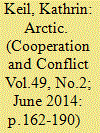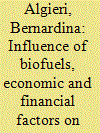|
|
|
Sort Order |
|
|
|
Items / Page
|
|
|
|
|
|
|
| Srl | Item |
| 1 |
ID:
132327


|
|
|
|
|
| Publication |
2014.
|
| Summary/Abstract |
Neorealist and neoliberal institutionalist explanations for the state and future of the Arctic region dominate the Arctic debate in international relations. While both schools focus on different aspects concerning the current and future state of Arctic affairs - neorealism evokes a confrontational rush for the Arctic's resources, whereas neoliberal institutionalism propagates the necessary reform of the institutional system governing Arctic issues - both share the underlying assumption of significant and rising stakes towards Arctic commodities. However, this article argues that this debate has hitherto failed to substantiate the actual stakes of the main actors involved. Consequently, many studies make grandiloquent statements about prospects of cooperation and conflict and the appropriate institutional framework for the Arctic region, based on only limited empirical support. This article aims to fill this gap by analysing the Arctic oil and gas interests of the five Arctic littoral states (Russia, USA, Canada, Norway and Denmark/Greenland). The analysis shows greatly different levels of interests towards the High North among the Arctic states. The findings make it possible to make more credible statements about the likelihood of confrontation over Arctic resources and necessary institutional adjustments. The evidence shows that the often-evoked issue of geopolitical rush for Arctic resources is unlikely to eventuate. Nonetheless, there remain institutional challenges for the protection of the fragile Arctic ecosystem.
|
|
|
|
|
|
|
|
|
|
|
|
|
|
|
|
| 2 |
ID:
129412


|
|
|
|
|
| Publication |
2014.
|
| Summary/Abstract |
Tensions around water distribution and consumption has assumed such proportions that experts have started talking about hydro-conflict and hydro-war in Central Asia . No other region in the world has faced such security peril linked to water. Crux of the matter is that water resources of the countries of
Central Asia are not distributed equitably. The region is clearly divided into water-rich States like Tajikistan and Kyrgyzstan on the one hand, and countries like Uzbekistan, Turkmenistan and Kazakhstan dependent on them for water, on the other. While Kirgyzstan controls the riverbasin of Syrdaria, Tajikistan controls water resources of Amudaria. Syrdaria is the longest and second largest in terms of water resources in Central Asia. Syrdaria with a length of 3019 km covers an area of 219 thousand square km. The major part, 75.2 percent of water resources of Syrdaria is formed in Kyrgyzstan, 15.25 percent on the territory of Uzbekistan, 6.9 percent in Kazakhstan and 2.7 percent in Tajikistan . Amudaria river has a length of 2540 km, with a basin of 309 square km. Like Syrdaria, Amudaria loses much of its water resources for irrigation purpose in the downstream. The major portion of water resources of Amudaria (74 percent) is formed on the territory of Tajikistan, while 13.9 percent of the water is formed in Afghanistan and Iran, and only 8.5 percent on the territory of Uzbekistan
|
|
|
|
|
|
|
|
|
|
|
|
|
|
|
|
| 3 |
ID:
132657


|
|
|
|
|
| Publication |
2014.
|
| Summary/Abstract |
Biofuels production has experienced rapid growth worldwide as one of the several strategies to promote green energy economies. Indeed, climate change mitigation and energy security have been frequent rationales behind biofuel policies, but biofuels production could generate negative impacts, such as additional demand for feedstocks, and therefore for land on which to grow them, with a consequent increase in food commodity prices. In this context, this paper examines the effect of biofuels and other economic and financial factors on daily returns of a group of commodity futures prices using Generalized Autoregressive Conditional Heteroskedasticity (GARCH) family models in univariate and multivariate settings. The results show that a complex of drivers are relevant in explaining commodity futures returns; more precisely, the Standard and Poor×s (S&P) 500 positively affects commodity markets, while the US/Euro exchange rate brings about a decline in commodity returns. It turns out, in addition, that energy market returns are significant in explaining commodity returns on a daily basis, while monetary liquidity is not. This would imply that biofuel policy should be carefully monitored in order to avoid excessive first-generation subsidization, which would trigger a fuel vs. food conflict.
|
|
|
|
|
|
|
|
|
|
|
|
|
|
|
|
| 4 |
ID:
133774


|
|
|
|
|
| Publication |
2014.
|
| Summary/Abstract |
U.S. politicians often work the topic of oil import independence into their campaign rhetoric as an ideal that would help separate U.S. economic prosperity and military responsibility from the volatility of Middle Eastern politics. In theory, oil independence would mean that events such as the Iranian revolution or internal political unrest in key Arab oil producers would have much less direct impact on the flow of oil to the United States, and thus U.S. prosperity (even if, in a global market for oil, the price impact of any supply disruption is shared by all consuming countries). More importantly, intra-state conflicts such as the Iraq-Iran war or the Iraqi invasion of Kuwait would not necessarily require large-scale U.S. military involvement to ensure oil production and exports to the United States and its allies. This linkage between U.S. oil import dependence and military commitment to the Gulf region has given rise to a myth favored by policymakers, markets, and the public that if the United States could attain oil independence, we could also reduce our military responsibilities around the world. Recent and ongoing changes in both the oil sector and in political-military strategy are for the first time in forty years combining in a manner that is leading some to believe this story could come true.
|
|
|
|
|
|
|
|
|
|
|
|
|
|
|
|
| 5 |
ID:
129413


|
|
|
|
|
| Publication |
2014.
|
| Summary/Abstract |
The problem of water supply and share of trans-boundary water resources today are particularly acute in Central Asia. Disruption of earlier economic relations between the former Soviet republics of Central
Asia led to widespread drop in production and reduced production of energy resources. Streamlined operation of reservoirs and delivery systems of energy resources began to falter. Central Asian States are
faced with the problem of the joint use of water resources in the region, which in the past were controlled from a single centre, Moscow. Changes in the political and economic situation in the region led to the sovereign States using water resources, primarily in their own national interest1. Water resources in Central Asia have always had and continue to have a significant impact on economic activities of the region, as all major rivers are trans-border i.e. cross the territory of two or more countries. Any change in water use by one of the countries that share common water ecosystems, or impact on water-course through construction of water facilities will inevitably affect the interests of others. Moreover, the lack of coordination can lead to a conflict, because the effects are often unfavourable for downstream countries, both for economic development and socio-environmental conditions.
|
|
|
|
|
|
|
|
|
|
|
|
|
|
|
|
|
|
|
|
|